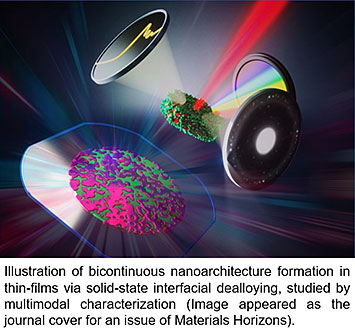A New Pathway to Highly-Interconnected Nanoarchitectures
December 30, 2019
What is the scientific achievement?
CFN users from Stony Brook University have discovered a new method for creating three-dimensional, highly-interconnected metallic thin-films. The new process takes an initial iron-nickel film and dealloys it with magnesium at low temperatures, resulting in a bicontinuous nanoarchitecture.
Why does this achievement matter?
This work advances mechanistic understanding of solid-state interfacial dealloying processes, and it provides a new synthesis route to highly-interconnected architectures useful for catalysis, sensing, and energy storage.
What are the details?
Bicontinuous-nanostructured materials with a three-dimensionally (3D) interconnected morphology offer unique properties and potential applications in catalysis, biomedical sensing, and energy storage. The new approach of solid-state interfacial dealloying (SSID) opens a route for fabricating bicontinuous metal–metal composites and porous metals at nano-/meso-scales via a self-organizing process driven by minimizing the system’s free energy. Integrating SSID and thin-film processing fully can open up a wide range of technological opportunities in designing novel functional materials; to-date, no experimental evidence has shown that 3D bicontinuous films can be formed with SSID, owing to the complexity of the kinetic mechanisms in thin-film geometry and at nano-scales, despite the simple processing strategy in SSID. Here, we demonstrate that a fully-interconnected 3D bicontinuous structure can be achieved by this new approach, thin-film SSID, using Fe–Ni film dealloyed by Mg film. The formation of a Fe–MgxNi bicontinuous 3D nanostructure was visualized and characterized via a multi-scale, multi-modal approach, combining electron transmission microscopy with synchrotron X-ray fluorescence nano-tomography and absorption spectroscopy. Phenomena involved with structural formation are discussed. These include surface dewetting, nano-size void formation among metallic ligaments, and interaction with a substrate. This work sheds light on the mechanisms of the SSID process, and sets a path for manufacturing of thin-film materials for future nanostructured metallic materials.
CFN Capabilities
The CFN Nanofabrication and Materials Synthesis Facilities were used for thin-film synthesis, and the Electron Microscopy Facility was used for sample characterization by imaging, tomography, and diffraction.
Publication Reference
C. Zhao, K. Kisslinger, X. Huang, M. Lu, F. Camino, C.H. Lin, H. Yan, E. Nazaretski, Y. Chu, B. Ravel, M. Liu, Y.C.K. Chen-Wiegart, Bi-continuous pattern formation in thin films via solid-state interfacial dealloying by multimodal characterization, Materials Horizons 6, 1991 (2019).
DOI: 10.1039/c9mh00669a
https://pubs.rsc.org/en/content/articlepdf/2019/mh/c9mh00669a
https://phys.org/news/2016-02-syracuse-chemists-combine-biology-nanotechnology.html
BNL Newsroom, Turning Up the Heat to Create New Nanostructured Metals: https://www.bnl.gov/newsroom/news.php?a=116830
Acknowledgement of Support
Work supported by the National Science Foundation under Grant No. DMR-1752839. Chen-Wiegart acknowledges the support provided via the Faculty Early Career Development Program (CAREER) program and Metals and Metallic Nanostructures program of the National Science Foundation. This research used resources, HXN (3-ID) and BMM (6-BM) beamlines, of the National Synchrotron Light Source II, a US Department of Energy (DOE) Office of Science User Facility operated for the DOE Office of Science by Brookhaven National Laboratory under Contract No. DE-SC0012704. This research used resources of the Center for Functional Nanomaterials, which is a U.S. DOE Office of Science Facility, at Brookhaven National Laboratory under Contract No. DE-SC0012704. The authors acknowledge the support from CFN staff: clean room access and training was provided by Gwen Wright. We thank the HXN beamline support at NSLS-II provided by Yan He, Michael Maklary and James Biancarosa. Chen-Wiegart group members are acknowledged for conducting the HXN beamtime experiment together and assisting with preliminary analysis: Cheng-Hung Lin, Xiaoyang Liu, Yu-Chung Lin, Lijie Zou. Karen Chen-Wiegart, Chonghang Zhao and Cheng-Hung Lin acknowledge the financial support by the Department of Materials Science and Chemical Engineering, the College of Engineering and Applied Sciences, and the Stony Brook University, as well as by the Brookhaven National Laboratory. Chonghang Zhao and Karen Chen-Wiegart are grateful for the support of a student fellowship by the Joint Photon Science Institute at Stony Brook University, jointly proposed by Karen Chen-Wiegart as PI and Yong Chu as co-PI and Juergen Thieme and Wah-Keat Lee as collaborators.
2019-17055 | INT/EXT | Newsroom










